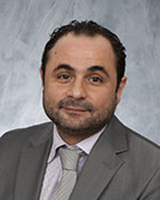Walid Farhat

Profile: Associate Scientist, SickKids Research Institute
Department: Surgery, University of Toronto
Lab: Farhat Lab
Research Interests:
My research revolves around urinary bladder tissue engineering and bladder development. The urinary bladder has become more of an example of dynamic organ; therefore all the research findings may eventually be translated into different areas of interest, particularly cardiovascular and intestinal regeneration. Organ tissue engineering and organogenesis is dependent on the presence of suitable scaffolds and extracellular matrix, cells and growth factors. From a biomaterials science and scaffold design perspective, we identified the different components of the natural scaffold that results in normal or abnormal regeneration. For that purpose, we identified and modified different methods of decellularization with the hope that the use of different detergents and cleansing agents for decellularization may have an impact on the cellularization potential and regenerative potential of the scaffolds. Hand in hand with us studying the scaffolds components, we also studied its mechanical properties, understanding that the mechanical properties are unique and important for different organs. Our lab has been involved in studying these three different elements of successful tissue engineering, dependently and interpedently. We have used acellular matrix as an example of a scaffold, and attempted to study methods of amplifying its regenerative capacity by adding different growth factors. Subsequently, we assess the growth factors in the new environment and the impact of the addition of growth factors on in vivo regeneration.
In terms of cells and cell sourcing, we have been investigating different cell phenotypes for the purpose of urinary bladder regeneration, albeit urothelial, smooth muscle from the baldder or mesenchymal stem cells harvested from the bone marrow. We have performed different studies identifying the quality and impact of cell matrix interaction in presence of growth factors and extracellular components such as the acellular matrix, collagen 1, collagen 3 and collagen 4. Our goal in the end is to identify the different players in regenerating the urinary bladder and developing a tissue engineering substitute.
Furthermore, we have been actively involved in studying and assessing the role of mechanical stimulation on cell matrix interaction in the context of dynamic organ regeneration. For that purpose we have invented in our lab a machine that allows cell seeded scaffolds to be subjected to different mechanical stimulation (Provisional Patent).
In the same scope of research that we have been developing over the last 10 years, we started looking into the different developmental pathways that are involved in the bladder development in a mouse model. We have been able to identify that the cavitation that may occur in the bladder is independent of filling and emptying or mecahincal stimulation. Rather, an epithelial to mesenchymal transition may be the driving force for cavitation in early bladder development. We have found that SMADS and TGF data may be unique players in the transition of epithelial to mesenchymal cell phenotype. This new discovery may be very valuable in different research areas, both in tissue engineering and cancer research.
Finally we have been working closely with other collaborators in studying and assessing cell specific regeneration and angiogenesis in different animal models, using non-invasive MRI imaging and use of natural scaffolds in different organs (calvarium).
